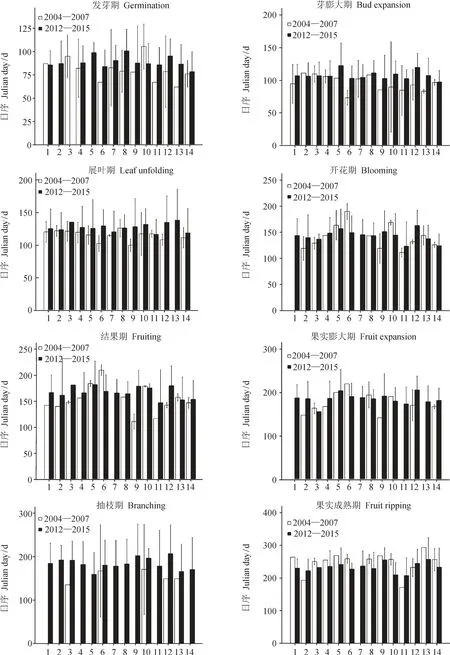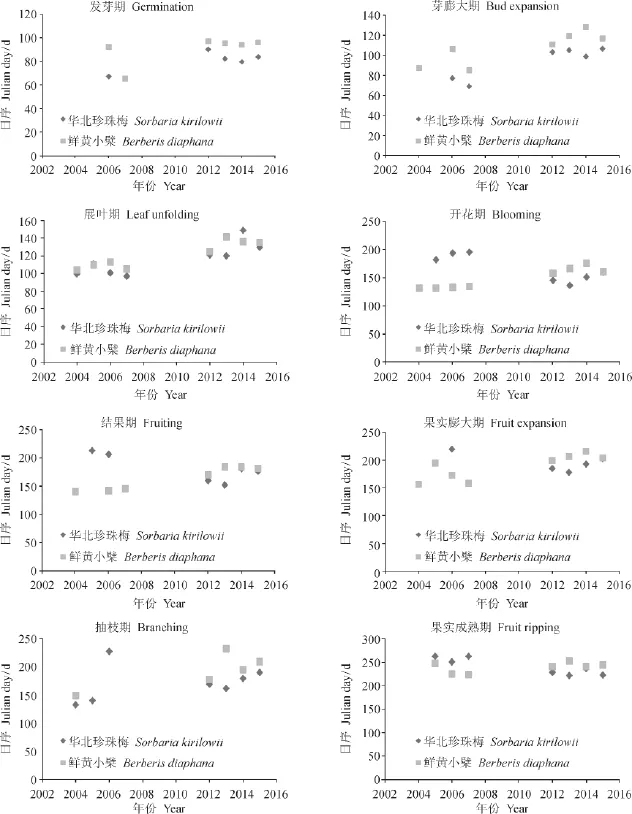兴隆山自然保护区优势植物的物候格局对气候变化的响应
2016-03-21潘世成孟秀祥
祁 军,王 静,潘世成,刘 瑞,孟秀祥
(1.甘肃兴隆山国家级自然保护区管理局,兰州 730117;2. 中国人民大学 环境学院,北京 100872)
兴隆山自然保护区优势植物的物候格局对气候变化的响应
祁 军1,2,王 静2,潘世成1,刘 瑞1,孟秀祥2
(1.甘肃兴隆山国家级自然保护区管理局,兰州 730117;2. 中国人民大学 环境学院,北京 100872)
甘肃兴隆山自然保护区地处青藏高原、黄土高原、蒙新高原交汇地带,区域内的植物物候变化对探索气候变化对该地区的生态影响有重要意义。本文对1951 — 2014年的气象数据进行了分析,结果表明:60年来,兴隆山地区的日均温呈逐年上升趋势,累积增温0.92℃,年降水量逐年下降,平均减少率为83.09 mm · (10a)-1。通过对比2004 — 2007年和2012 — 2015年间两时间段内的鲜黄小檗(Berberis diaphana)等14种植物物种的开花等8种物候现象的发生时间发现,有42.86%的观测物种的物候存在显著差异,其中华北珍珠梅(Sorbaria kirilowii)、鲜黄小檗最为显著。鲜黄小檗物候期都呈推迟趋势。华北珍珠梅的春季物候期推迟,秋季物候期提前,其生长季减少率为15.49 d · a-1。在保护区的植被管理实践中,应特别加强对华北珍珠梅的保育。
兴隆山自然保护区;气候变化;物候期;优势植物
以气候变暖为主要特征的气候变化受到社会各界的广泛关注,IPCC第五次评估报告(秦大河等,2014)显示近130多年来,全球地表年平均温度上升了0.85℃,其中1951 — 2012年全球地表年平均气温平均每10年上升0.12℃,是1880 — 1950年的近两倍;而近60年来我国地表平均气温每10年上升0.23℃,气候变暖的幅度明显高于全球。物候是指示气候变化的主要指标之一(丁抗抗等,2010),是指生物长期适应温度条件的周期性变化,形成与此相适应的生长发育节律,主要指动植物的生长、发育、活动规律与非生物的变化对节候的反映(陆佩玲等,2006)。
甘肃兴隆山保护区地处我国黄土高原、青藏高原和蒙新高原的交汇地带(刘鸿源等,2012),是我国的“绿色岩岛”、生物多样性中心及重要基因库,区内海拔跨度大、生态系统类型齐全,濒危植物及特有植物物种极多(魏强等,2011)。然而,目前国内外开展的植被物候观测与预测研究对象多为中高纬度地区的植物,对“过渡带”地区的物候研究较少。在全球变暖的气候背景下,研究“过渡带”地区的植物对气候变化的响应,是亟待解决的重要科学问题。对兴隆山保护区主要树种物候期的连续观测,系统记录物种的发芽、展叶、开花、枝条生长、结果及落叶等关键物侯格局,结合长时序气象数据分析阐明局域气候变化对兴隆山植物物候的效应及作用机制,其结果将为保护区的资源保护、林副业生产、病虫害防治、生态旅游等提供科学依据和参考。
1 研究方法
1.1 研究区概况
兴隆山自然保护区位于甘肃省兰州市东南部的榆中县境内(103°50′ — 104°10′E、35°38′ — 35°58′N),属祁连山的东延余脉,总面积约295.84 km2,属于森林生态系统类型的国家级保护区,主要保护对象为野生动物马麝(Moschus chrysogaster)、原始云杉林(Picea asperata)及其相应的生态系统。总的气候特征表现为温带半湿润气候,属于大陆性气候,春季多风少雨,夏季降水增多。保护区初霜冻一般发生在10月初,终霜冻在5月中、下旬,主要的气象灾害包括霜冻、冰雹和暴雨。保护区内平均温度为4.1℃,平均年降水量为621.6 mm,平均年蒸发量为918.6 mm,相对湿度68%(祁军等,2009)。
1.2 观测物种的选定
由于研究区域内物种涵盖层次多样,故特定选取以下14种优势物种作为观测对象,包括5种乔木:白桦(Betula platyphylla)、辽东栎(Quercus wutaishansea)、落叶松(Larix gmelinii)、山杨(Populus davidiana)、油松(Pinus tabulaeformis);9种灌木:刺毛樱桃(Cerasus setulosa)、刺鼠李(Rhamnus dumetorum)、甘肃山楂(Crataegus kansuensis)、互叶醉鱼草(Buddleja alternifolia)、华北珍珠梅(Sorbaria kirilowii)、黄蔷薇(Rosa hugonis)、山梅花(Philadelphus incanus)、鲜黄小檗(Berberis diaphana)、紫丁香(Syringa oblata)。
1.3 物候观测方法
参照《中国物候观测方法》(宛敏渭和刘秀珍,1979),在2004 — 2007年、2012 — 2015年分别进行了连续观测记录,当观测对象有物候现象变化时,加强观测次数,进行每日观测,将观测对象50%出现变化的当天,即该物候现象的高峰期,确定为对应的物候期。
观测并记录的物候期包括:发芽期,即50%的枝条出现新芽;芽膨大期,即枝条上的50%新芽已经膨大,即芽的鳞片开始分裂或分离;展叶期,即50%卷曲的小叶出现叶片平展时的阶段;开花期,即50%的花朵开放,且雌蕊、雄蕊从花被中暴露出来;结果期,即50%的果实长出;果实膨大期,即50%的幼果膨大,体形增大;抽枝期,即50%的老枝条上出现新枝;果实成熟期,即50%果实成熟,出现颜色变化或体形变化。
1.4 数据处理
气候数据来源于中国气象科学数据共享服务网,包括1951 — 2014年甘肃省兰州市榆中县日最高温、日最低温、日均温、日降水量的数据。
对于2004 — 2007年及2012 — 2015年所有物候数据,将所记录的全部物候期转为日序,即为距当年1月1日的天数,并对其进行数理统计分析。通过t检验判断观测物种两阶段的物候期有无显著差异,对有显著差异的物候,用具有生态学意义的最优模型分别对物候期和年份进行回归分析,所有操作均在Excel、SPSS软件平台上进行。
2 研究结果
2.1 气候变化趋势
2.1.1 气温变化趋势
(1)年内温度变化
如图1所示,兴隆山地区年内气温呈抛物线状分布,其变化具有季节性。冬季(12月、1月、2月)的平均温度均在冰点温度以下,其中1月平均气温达(-7.63 ± 0.56)℃,为全年温度最低月份,平均最低温度可达(-13.20 ± 0.56)℃;平均温度最高为7月,达(18.90 ± 0.48)℃,平均最高温度可达(25.64 ± 0.52)℃。

图1 兴隆山地区1951 — 2014年月平均气温变化图Fig.1 Average monthly temperature change from 1951 — 2014 in Xinglongshan Natural Reserve
(2)年际温度变化
对60余年的气温年际变化进行分析,如图2所示,可知60余年的气温变化主要可分为四个阶段:第一阶段(1951 — 1960年)呈上升趋势;第二阶段(1960 — 1980年)气温下降,其中20世纪70年代到20世纪80年代平均气温均为6.53℃,但20世纪80年代的气温变率略大于20世纪70年代(Yr= 0.045 > 0.042);第三阶段(1980 — 2008年)气温上升;第四阶段(2008 — 2014年)又出现年均温下降的变化趋势。
总体来看,兴隆山地区气温呈上升趋势,达0.15℃· (10a)-1,并以0.17℃· (10a)-1的速率增加,63年间累计增加了0.95℃。最高气温出现在2006年,年平均温度达8.04℃;最低气温出现在1952年,年平均温度为4.03℃,两者相差4.01℃,上升幅度很大。
2.1.2 降水变化趋势
(1)年内降水量变化
兴隆山地区夏季多雨水,月降水量呈抛物线分布,对年内降水量进行曲线拟合,模型为y= 25.875x3+ 28.875x2- 2.616x- 89.765的拟合效果较好(R2= 0.84)(图3)。

图2 兴隆山地区1954 — 2014年气温年际变化图Fig.2 Yearly temperature change from 1954 — 2014 in Xinglongshan Natural Reserve

图3 兴隆山地区1951 — 2014月降水量变化图Fig.3 Monthly precipitation from 1951 — 2014 in Xinglongshan Natural Reserve
年均降水量为316.19 mm,主要为7、8月大量降水,降水峰值为8月,其平均降水量达807.00 mm。冬季(12月、1月、2月)降水量很少,且多以降雪的形式,最低降水量出现在12月,仅15.78 mm。
(2)年际降水量变化
如图 4所示,兴隆山地区历年降水量变化可分为三个阶段。1960年以前年降水量呈上升趋势,1960 — 1980年降水量减少,1980 — 2000年降水量基本持平,2000至今年降水量缓慢减少,除2007年降水量远高于平均值外(5555.00 mm > 3794.25 mm),多数年份降水量低于历年降水量平均值。

图4 兴隆山地区1951 — 2014年降水量年际变化Fig.4 Yearly precipitation from 1951 — 2014 in Xinglongshan Natural Reserve
对60余年来兴隆山地区年降水量进行线性拟合,模型为y= -8.3085x+ 4135.8,R² = 0.53,即年降水量以83.09 mm · (10a)-1的速率减少,趋势较为明显。年降水量最高值出现在1964年,年降水量达6073.00 mm,而在2011年,年降水量为2628.00 mm,不到前者的1/2,降水量差异显著。
2.2 物候期变化
2.2.1 两个阶段对比
如图5所示,对比2004 — 2007年和2012 — 2015年两个阶段不同观测物种的物候期,2012 — 2015年辽东栎发芽期较2004 — 2007年明显推迟(P= 0.032 < 0.05);白桦、华北珍珠梅、山杨、鲜黄小檗芽膨大期显著推迟(P= 0.018<0.05;P= 0.01 < 0.05;P= 0.0045 < 0.05;P= 0.005<0.05);华北珍珠梅、落叶松、鲜黄小檗展叶期显著推迟(P= 0.001 < 0.05;P= 0.044 < 0.05;P= 0.024 < 0.05);华北珍珠梅、鲜黄小檗开花期两阶段均有显著变化,但华北珍珠梅表现为开花期提前(P= 0.001 < 0.05),而鲜黄小檗却表现为开花期推迟(P= 0.001 < 0.05);同样,对于两个时间段的结果期而言,有显著变化的观测物种,其变化趋势却不同:华北珍珠梅表现出结果期提前的趋势(P= 0.005 < 0.05),而落叶松、鲜黄小檗结果期显著推迟(P= 0.001 < 0.05;P= 0.007 < 0.05);鲜黄小檗果实膨大期显著推迟(P= 0.003 < 0.05);华北珍珠梅、山梅花果实成熟期显著提前(P= 0.000 < 0.05;P= 0.010 < 0.05);即包括白桦、华北珍珠梅、山杨、鲜黄小檗的大部分春季物候期(发芽期、芽膨大期、展叶期、开花期)明显提前;华北珍珠梅、落叶松、鲜黄小檗、山梅花的秋季物候期(结果期、果实膨大期、果实成熟期)明显推迟。即有42.86%的观测物种的2012 — 2015年物候期明显区别于2004 — 2007年,其中华北珍珠梅、鲜黄小檗这两种物种的春季物候期和秋季物候期均有明显变化。由于不同植物对气候变化的敏感性不同,对其作出的响应也不尽相同,表现为物候期的推迟或者提前。
2.2.2 变化趋势
对2012 — 2015年物候期显著区别于2004 — 2007年的观测物种,即华北珍珠梅和鲜黄小檗的趋势预测如图 6所示。
对于鲜黄小檗而言,结果期约推迟4.53 d·a-1(y= 4.5311x- 8944.7,R² = 0.95),展叶期约推迟3.18 d·a-1(y= 3.1793x- 6267.7,R² = 0.87),开花期约推迟3.91 d·a-1(y= 3.9149x- 7719,R² = 0.89);而对于华北珍珠梅,其物候期变化线性拟合较好的包括:芽膨大期约推迟3.97 d·a-1(y= 3.9676x- 7886.4,R² = 0.86),果实成熟期约提前3.83 d·a-1(y= - 3.8339x+ 7948.6,R² = 0.82)。
总体来看,鲜黄小檗所有的物候期都呈现推迟的趋势,其中推迟现象最明显的就是结果期;而对于华北珍珠梅既有物候期推迟的物候型,也有物候期提前的物候型,果实膨大期、结果期、果实成熟期和开花期候期提前,其中最显著的是果实成熟期,而包括以芽膨大期为代表的抽枝期、发芽期、展叶期,呈现物候期推迟的趋势,即华北珍珠梅的春季物候期多数呈现推迟趋势,秋季物候期主要呈现提前的趋势,整个生长季(春季物候 — 秋季物候)的时间会减短,可多达15.49 d·a-1,不利于华北珍珠梅的生长发育。
3 分析与结论
近60年的气候数据显示,兴隆山地区整体呈现气温逐年上升(0.15℃· (10a)-1),降水量逐年下降(-83.09 mm · (10a)-1)的趋势,这和先前对该地区的气象研究结果基本一致,如1951 — 2010年对甘肃省气温变化的研究结果显示60年间全省气温增长率为0.175℃· (10a)-1(马玉霞和张军,2012),1961 — 2008平均年降水量总线性趋势变化率为-80.77 mm · (10a)-1(杨封科等,2015)。

图5 观测植物种2004 — 2007年与2012 — 2015年物候期对比(注:1.白桦;2.刺毛樱桃;3.刺鼠李;4.甘肃山楂;5.互叶醉鱼草;6.华北珍珠梅;7.黄蔷薇;8.辽东栎;9.落叶松;10.山梅花;11.山杨;12.鲜黄小檗;13.油松;14.紫丁香)Fig.5 Compared the phenophases of observed plants between 2004 — 2007 and 2012 — 2015 (Note: 1.Betula platyphylla; 2.Cerasus setulosa; 3.Rhamnus dumetorum; 4.Crataegus kansuensis; 5.Buddleja alternifolia; 6.Sorbaria kirilowii; 7.Rosa hugonis; 8.Quercus wutaishansea; 9.Larix gmelinii; 10.Philadelphus incanus; 11.Populus davidiana; 12.Berberis diaphana; 13.Pinus tabulaeformis; 14.Syringa oblata)

图6 华北珍珠梅和鲜黄小檗的各物候期年份变化Fig.6 Phenophases changes ofSorbaria kirilowiiandBerberis diaphanafrom 2004 — 2007 and 2012 — 2015
但由于兴隆山地处青藏高原、黄土高原、蒙新高原的交汇地带,受地形等因素影响,其气温变化的速率稍缓于全国平均水平(0.23℃· (10a)-1)(秦大河等,2014),而本研究范围兰州市榆中县位于兰州市东南部,甘肃省南部地区,正好处在干旱半干旱整体南移(宁惠芳等,2010)的范围内,和年降水量下降的趋势相符合。
整体来看,兴隆山地区温度逐年升高,降水量逐年减少。降水量能够直接改变保护区内可燃物的湿度,因而在降水量较低(1月份、2月份、3月份、12月份)的月份,要尤其注意森林防火。由于保护区为内陆大陆性气候,春季干燥多风,冬季冷旱降水少,风对森林火灾的形成和发展影响巨大(张爱萍,2015a)。此外,已有研究表明保护区近年的火警、火灾的发生主要出现在清明节前后(张爱萍,2015b),起火的导火索主要是人为因素,如烧地埂、野外烧秸秆、上坟烧纸等。所以在降水量少、风力增强、人为引发火灾风险较大的3月份要格外加强森林火灾的防护工作。
通过对比2004 — 2007年及2012 — 2015年两个阶段的物候期,可以发现42.86%的观测物种物候出现显著变化,其中华北珍珠梅、鲜黄小檗最为显著。华北珍珠梅的春季物候期推迟,秋季物候期提前,整个生长季(春季物候 — 秋季物候)的时间减短,可达15.49 d· a-1。虽然对1963 — 2008年的研究中显示,哈尔滨珍珠梅的芽开放期提前7.5 d,展叶期提前9.2 d,开花期提前17.8 d,即呈现春季物候期提前的趋势(李长海等,2011);但对1982 — 1999年中国北方植被生长季空间变化研究显示,甘肃部分地区植被生长季结束较早(王宏等,2007)。此外,兴隆山自然保护区2004 — 2014年温度呈现下降趋势(y= -0.0186x+ 7.5058,R² = 0.02),而且物候期受温度、降水等各方面因素影响,这可能是兴隆山保护区内华北珍珠梅春季物候期呈现推迟趋势的原因,需要进一步的探究。
鲜黄小檗物候期整体呈现推迟的趋势,这和植物本身特性相关,鲜黄小檗的耐寒性强于华北珍珠梅,在引种到内蒙古地区时,越冬率达到100%(任利超,2011)。其耐寒性部分解释了其在温度下降的情况下春季、秋季物候期均呈现推迟的趋势,但其具体原因需要进一步探讨。此外,虽然鲜黄小檗物候期均呈现推迟的趋势,但生长季的变化不清楚,需要下一步分析。
生长季的缩短不利于植物的生长繁育,因而对于这种物候期变化明显的植物,尤其是具有极大生态价值、经济价值的植物,需要加强保护保育工作。由于水热条件的变化,也可能导致观测物种的分布范围的变化(王鹤龄等,2008),需要长时间的持续观测。
丁抗抗, 高庆先, 李 辑. 2010. 我国植物物候变化及对气候变化的响应综述[J].安徽农业科学, 38(14): 7414 – 7417. [Ding K K, Gao Q X, Li J. 2010. Review on the plant phenology changes in China and the responses to the climate changes [J].Journal of Anhui Agricultural Sciences, 38(14): 7414 – 7417.]
李长海, 裴顺祥, 郭泉水,等. 2011. 哈尔滨市3种灌木物候对气候变化的响应[J].东北林业大学学报, 39(5): 58 – 61. [Li C H, Pei S X, Guo Q S, et al. 2011. Phenological responses of three shrub species to climate change in Harbin, Heilongjiang Province [J].Journal of Northeast Forestry University, 39(5): 58 – 61.]
刘鸿源, 魏 强, 凌 雷. 2012.甘肃兴隆山森林生态效益评价指标体系与方法[J].中国水土保持, (11): 52 – 54. [Liu H Y, Wei Q, Ling L. 2012. Gansu Xinglong mountain forest ecological benefit evaluation index system and method [J].Soil and Water Conservation in China, (11): 52 – 54.]
陆佩玲, 于 强, 贺庆棠. 2006. 植物物候对气候变化的响应[J].生态学报, 26(3) : 923 – 929.[Lu P L, Yu Q, He Q T. 2006. Responses of plant phenology to climatic change [J].Acta Ecologica Sinica, 26(3): 923 – 929.]
马玉霞, 张 军. 2012. 甘肃省近60年气温变化特征分析[C]//中国气象学会. 第29届中国气象学会年会: S7 气候环境变化与人体健康. 沈阳: 中国气象学会. [Ma Y X, Zhang J. 2012. The analysis of characteristics of temperature change in Gansu Province nearly 60 years [C]// Chinese Meteorological Society. The 29th annual meeting of China Meteorological Society: S7 climate change and human health. Shenyang: Chinese Meteorological Society.]
宁惠芳, 林婧婧, 陈佩璇. 2010. 甘肃省气候暖干化与农业干旱灾害的联系[J].干旱气象, 28(2): 198 – 201. [Ning H F, Lin J J, Chen P X. 2010. Impacts of warming and drying climate on agricultural drought disaster in Gansu Province [J].Journal of Arid Meteorology, 28(2): 198 – 201.]
祁 军, 张学炎, 芦月芳,等. 2009. 兴隆山自然保护区植物物候观测研究[J].甘肃林业科技, 34(3): 36 – 40. [Qi J, Zhang X Y, Lu Y F, et al. 2009. Phenological research on plant in Xinglongshan nature reserve [J].Journal of Gansu Forestry Science and Technology, 34(3): 36 – 40.]
秦大河, Thomas S, 259名作者和TSU(驻伯尔尼和北京). 2014. IPCC第五次评估报告第一工作组报告的亮点结论[J].气候变化研究进展, 10(1): 1 – 6. [Qin D H, Thomas S, 259 Authors and TSU (Bern & Beijing).2014. Highlights of the IPCC Working GroupⅠ Fifth Assessment Report [J].Progressus Inquisitiones de Mutatione Climatis, 10(1): 1 – 6.]
任利超. 2011. 白云鄂博矿区13种木本植物引种及耐旱耐寒性研究[D]. 北京: 北京林业大学. [Ren L C. 2011. Study on introduction of 13 woody plants and their resistance to drought and cold in Bayan Obo [D]. Beijing: Beijing Forestry University.]
宛敏渭, 刘秀珍. 1979. 中国物候观测方法[M]. 北京: 科学出版社. [Wan M W, Liu X Z. 1979. Chinese phenology observation method [M]. Beijing: Science Press.]
王鹤龄, 邓振镛, 王润元,等. 2008. 甘肃省越冬作物对气候变暖响应及其原因研究[C]// 中国气象学会. 中国气象学会2008年年会论文集. 北京: 中国气象学会. [Wang H L, Deng Z Y, Wang Y Y, et al. 2008. Responses of winter crops to climate warming planting in Gansu Province [C]// Chinese Meteorological Society. Proceedings of 2008 annual meeting of China Meteorological Society. Beijing: Chinese Meteorological Society.]
王 宏, 李晓兵, 李 霞,等. 2007. 基于NOAA NDVI和MSAVI研究中国北方植被生长季变化[J].生态学报, 27(2): 504 – 515. [Wang H, Li X B, Li X, et al. 2007. The variability of vegetation growing season in the northern China based on NOAA NDVI and MSAVI from 1982 to 1999 [J].Acta Ecologica Sinica, 27(2): 504 – 515.]
魏 强, 凌 雷, 张广忠,等. 2011. 甘肃兴隆山主要森林类型凋落物累积量及持水特性[J].应用生态学报, 22(10): 2589 – 2598. [Wei Q, Ling L, Zhang G Z, et al. 2011. Water-holding characteristics and accumulation amount of the litters under main forest types in Xinglong Mountain of Gansu, Northwest China [J].Chinese Journal of Applied Ecology, 22(10): 2589 – 2598.]
杨封科, 何宝林, 高世铭. 2015. 气候变化对甘肃省粮食生产的影响研究进展[J].应用生态学报, 26(3): 930 – 938. [Yang F K, He B L, Gao S M. 2015. Impacts of climate change on food production in Gansu: A review [J].Chinese Journal of Applied Ecology, 26(3): 930 – 938. ]
张爱萍. 2015a. 森林气候对甘肃兴隆山防火工作的影响[J].北京农业, (28): 108 – 109. [Zhang A P. 2015a. Forest climate infl uence on gansu xinglong mountain fi re prevention work [J].Beijing Agriculture, (28): 108 – 109.]
张爱萍. 2015b. 兴隆山国家级自然保护区森林防火现状及预防措施[J].甘肃林业科技, 40(2): 48 – 51. [ Zhang A P. 2015b. Situation and preventive measures of forest fi re prevention in Xinglong Mountain National Nature Reserve [J].Journal of Gansu Forestry Science and Technology, 40(2): 48 – 51.]
The phenological patterns of dominant plants in Xinglongshan Natural Reserve and the response to the regional climate change
QI Jun1,2, WANG Jing2, PAN Shicheng1, LIU Rui1, MENG Xiuxiang2
(1. Gansu Xinglongshan National Nature Reserve, Lanzhou 730117, China; 2. School of Environment and Natural Resources, Renmin University of China, Beijing 100872, China)
Background, aim, and scopeGlobal warming as the main characteristics of the climate change received extensive attention of the society from different fi elds. Phenology is one of the main indicators of climate change. Gansu Xinglongshan National Reserve is located at the intersection among Tibetan Plateau, Loess Plateau and Mengxin Plateau; the phenological period in where can be an important indicator of climate change. However, researches at home and abroad of vegetation phenology observation and prediction are focused on that in high latitudes, the phenological study of “transition zone” region is relative less. Therefore, solving the demanding problem can benefit future longtime phenological observations and predictions, which provide scientific proof for conservation and management.Materials and methodsClimate data are provides by China meteorological data sharing service system, including the highest temperature, lowest temperature, average temperature and daily precipitation from 1951 — 2014 in Yuzhong County, Gansu Province. Phenological data of 14 plants are recorded artifi cially in Xinglongshan Natural Reserve from 2004 — 2007 and 2012 — 2015, including 8 phenophases, namelygermination, bud expansion, leaf unfolding, blooming, fruiting, fruit expansion, branching and fruit ripping, and making the day when 50% twigs of observation have the phenological appearance as the corresponding phenophase. Then use Julian Day series to transfer all phenological data, and analyzing the change pattern by fitting, the relationship between regional climate data and phenological data by correlation and fi tting.ResultsThe temperature in Xinglongshan increased year by year, reaching 0.92℃in 60 years. While monthly precipitation tends to decrease at the rate of 83.09 mm · (10a)-1. Compared the 8 phenological phases of 14 observed species, 42.86% have the signifi cant change, especially forSorbaria kirilowiiandBerberis diaphana. The former species has shorter grow season for later spring phenophase and earlier autumn phenophases, reaching 15.49 d · a-1, and for the later species, the whole phenological period delay.DiscussionThe result of regional climate change in this research is similar with the former research result, namely have the same change tendency of increase in temperature and decrease in precipitation. However, because Xinglongshan National Natural Reserve is located at the Qinghai, Tibet and Mengxin Plateau, the coastal area of these plateaus, affected by the factors such as topography, its temperature change rate is a bit slow than the average rate in China. What is more, the research scope, Yuzhong County is located in the southeast of Lanzhou City, the southern part of Gansu Province, where is in the scale that arid and semi-arid move to south, and the annual precipitation decreased. The change pattern of phenophases is identical with the former research in northern part of China from 1982 — 1999.Sorbaria kirilowiiandBerberis diaphanashow different change tendency and response to regional climate change because its own characteristics, especially the cold tolerance of the later one.ConclusionsThe regional climate change in Xinglongshan National Natural Reserve have the tendency of increasing in temperature and decrease in precipitation, which is similar with most former study on relative area, and the change of phenophases of 14 observed plants, also the dominant plants in this study area, showing the tendency of delaying or in advance because of own characters. There are two plants, namelySorbaria kirilowiiandBerberis diaphana, showing significant change among 14 observations. The former one has a shorter growing season caused by higher temperature and less precipitation, while the later one has the tendency of delaying on all kinds of phenophases because of its better resistant ability against cold.Recommendations and perspectivesPrecipitation can directly change the humidity of fuel, and therefore in the month with low precipitation (January, February, March and December), should pay special attention to forest fi re prevention. Due to the inland continental climate in Xinglongshan National Natural Reserve, where has a dry and windy spring, and less rainfall in cold dry winter, and the wind effect on the formation and development of forest fire. In addition, the existing research shows that reserves in recent years, the occurrence of fi re mainly appears in the period before and after Qingming Festival, the fuse of the fi re is mainly man-made factors, such as burning DeGeng, fi eld burning straw, grave burn, etc. So when there are less rainfall, stronger wind and higher man-made fi re risk, namely around March, extra work to strengthen the protection of forest fi re is strongly needed. Because of the regional climate change, including temperature and precipitation, the phenological change in observed plants provide us management suggestions. For theSorbaria kirilowii, the shorter growing season will be unfavorable to its growth, and it continue the decreasing trend, it is necessary to strengthen artifi cial conservation work for it. However the mechanism of how plants response to climate change and why plants have different response to same climate change need to future study, and the longtime constant phenological observation can be helpful to solve this problem and showing a more specifi c and real change pattern on phenology, which benefi ts on better prediction and useful management measures.
Xinglongshan Natural Reserve; climate change; phenophases; dominant plants
MENG Xiuxiang, E-mail: meng2014@ruc.edu.cn
10.7515/JEE201603005
2016-02-29;录用日期:2016-04-19
Received Date:2016-02-29;Accepted Date:2016-04-19
2015年度甘肃省省级林业科技计划项目(2015kj056);香港海洋公园保育基金(OPCFHK)项目(TM01_1516)
Foundation Item:Gansu Provincial Forestry Science and Technology Plan for 2015(2015kj056) ; Ocean Park Conservation Fundation Hong Kong (TM01_1516)
孟秀祥,E-mail: meng2014@ruc.edu.cn
